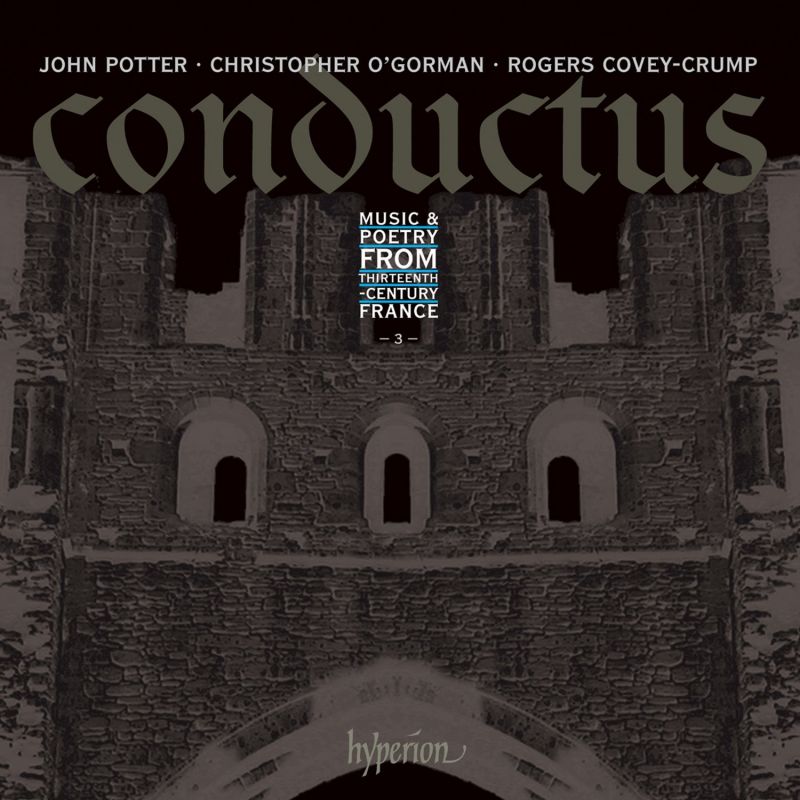Conductus: Music & poetry from thirteenth-century France
View record and artist detailsRecord and Artist Details
Composer or Director: Anonymous
Genre:
Vocal
Label: Hyperion
Magazine Review Date: 04/2016
Media Format: CD or Download
Media Runtime: 62
Mastering:
DDD
Catalogue Number: CDA68115

Tracks:
| Composition | Artist Credit |
|---|---|
| Fas et nefas |
Anonymous, Composer
Anonymous, Composer Christopher O'Gorman, Tenor John Potter, Tenor Rogers Covey-Crump, Tenor |
| A globo veteri |
Anonymous, Composer
Anonymous, Composer Rogers Covey-Crump, Tenor |
| Vite perdite |
Anonymous, Composer
Anonymous, Composer Christopher O'Gorman, Tenor John Potter, Tenor |
| A l'entrant del tans salvage |
Anonymous, Composer
Anonymous, Composer Christopher O'Gorman, Tenor |
| Per dan que d'amor mi veigna |
Anonymous, Composer
Anonymous, Composer John Potter, Tenor |
| O qui fontem gratie |
Anonymous, Composer
Anonymous, Composer Christopher O'Gorman, Tenor John Potter, Tenor |
| Transgressus legem Domini |
Anonymous, Composer
Anonymous, Composer Christopher O'Gorman, Tenor John Potter, Tenor Rogers Covey-Crump, Tenor |
| Sede, Syon, in pulvere |
Anonymous, Composer
Anonymous, Composer Christopher O'Gorman, Tenor |
| Olim sudor Herculis |
Anonymous, Composer
Anonymous, Composer John Potter, Tenor |
| Eclypsim passus totiens |
Anonymous, Composer
Anonymous, Composer Christopher O'Gorman, Tenor |
| Homo, natus ad laborem |
Anonymous, Composer
Anonymous, Composer Christopher O'Gorman, Tenor John Potter, Tenor Rogers Covey-Crump, Tenor |
Author: David Fallows
Now that all three discs are available, though, it becomes easier to see that the set represents two basic views that have their adherents but may lessen the enjoyment to be gained here. First, that music of the 13th century is quite unlike later music in that it doesn’t reflect the content of its texts: thus the song of open seduction in Al entrant del tans salvage sounds not much different from the song of unrequited love (with the same melody), Per dan que d’amor mi veigna, and so on. The second concerns the notation of the melismatic (sine littera) sections and the syllabic ones (cum littera). I need to get technical here, but it seems important so that listeners understand why some of the music is a touch boring. Again and again in the conductus repertory, the sine littera sections are in regular ligatures that are easily read in the ‘rhythmic modes’ described by the theorists; by contrast, the cum littera sections appear in the manuscripts in equal note-values. For years, it was concluded logically enough that the metrical structure established in the sine littera sections should be continued in the cum littera sections. But as of about 30 years ago scholars began to doubt this. So the present set jerks from the lilting rhythms of the sine littera sections to an equisyllabic presentation of the texted sections. To my ear this almost always makes no sense. That is not to say that the entire conductus repertory must be interpreted in the same way. But it is to say that somehow the baby has been thrown out with the bathwater.
Discover the world's largest classical music catalogue with Presto Music.

Gramophone Digital Club
- Digital Edition
- Digital Archive
- Reviews Database
- Full website access
From £8.75 / month
Subscribe
Gramophone Full Club
- Print Edition
- Digital Edition
- Digital Archive
- Reviews Database
- Full website access
From £11.00 / month
Subscribe
If you are a library, university or other organisation that would be interested in an institutional subscription to Gramophone please click here for further information.




